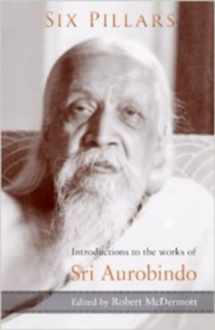
Six Pillars: Introductions to the Works of Sri Aurobindo
ISBN-13:
9781584200925
ISBN-10:
1584200928
Edition:
Revised ed.
Author:
Sri Aurobindo, Robert A. McDermott
Publication date:
2012
Publisher:
Lindisfarne Books
Format:
Paperback
216 pages
Category:
Occultism
,
Occult & Paranormal
,
Mysticism
,
Other Religions, Practices & Sacred Texts
,
Eastern
,
Philosophy
FREE US shipping
Book details
ISBN-13:
9781584200925
ISBN-10:
1584200928
Edition:
Revised ed.
Author:
Sri Aurobindo, Robert A. McDermott
Publication date:
2012
Publisher:
Lindisfarne Books
Format:
Paperback
216 pages
Category:
Occultism
,
Occult & Paranormal
,
Mysticism
,
Other Religions, Practices & Sacred Texts
,
Eastern
,
Philosophy
Summary
Six Pillars: Introductions to the Works of Sri Aurobindo (ISBN-13: 9781584200925 and ISBN-10: 1584200928), written by authors
Sri Aurobindo, Robert A. McDermott, was published by Lindisfarne Books in 2012.
With an overall rating of 3.9 stars, it's a notable title among other
Occultism
(Occult & Paranormal, Mysticism, Other Religions, Practices & Sacred Texts , Eastern, Philosophy) books. You can easily purchase or rent Six Pillars: Introductions to the Works of Sri Aurobindo (Paperback) from BooksRun,
along with many other new and used
Occultism
books
and textbooks.
And, if you're looking to sell your copy, our current buyback offer is $0.3.
Description
Sri Aurobindo (1872-1950) was one of the great twentieth-century figures of India. Over the course of his lifetime, he helped India's struggle for freedom and became a leading yogi, philosopher, and poet of his time and culture. In his teaching, Sri Aurobindo went well beyond Eastern philosophy and religion, synthesizing it with Western traditions, even spending two years of his youth at Loreto Convent in Darjeeling, West Bengal. In 1879, Aurobindo and his two elder brothers were taken to Manchester, England for a European education and placed in the care of Rev. Drewett, an Anglican clergy, and his wife. In 1884, Aurobindo joined St. Paul's School, where he learned Greek and Latin and spent three years studying literature, especially English poetry. By 1910, Sri Aurobindo's focus was directed entirely toward spirituality, and he settled in Pondicherry, India, where he taught, wrote, and published his greatest works. His spiritual vision extended beyond the perfection and transformation of the individual to include the evolution and transformation of human society. According to his teaching, a true solution to humanity's problems arises from a radical transformation of human life into a form of divine existence. “The one aim of [my] yoga is an inner self-development by which each one who follows it can in time discover the One Self in all and evolve a higher consciousness than the mental, a spiritual and supramental consciousness which will transform and divinize human nature.” ―Sri AurobindoFor everyone interested in the philosophical and spiritual vision of the great Indian thinker Sri Aurobindo, the revolutionary turned yogi, this outstanding collection of masterly introductions, first published in 1974, offers original reflections and interpretations of Sri Aurobindo’s six major works, all written by distinguished scholars of religion and philosophy rather than devotees. Long out of print and difficult to find, Six Pillars is again available for contemporary readers. Contents: John Collins: “Savitri: Poetic Expression of Spiritual Experience” Thomas Berry: “The Foundations of Indian Culture: its Contemporary Significance” Thomas J. Hopkins: “The Vision of the Purushottama in Essays on the Gita” J. Bruce Long: “A New Yoga for a New Age: A Critical Introduction to The Synthesis of Yoga” Eugene Fontinell: “A Pragmatic Approach to the Human Cycle” Robert McDermott: “The Life Divine: Sri Aurobindo’s Philosophy of Evolution and Transformation” Introductions to the Major Works of Sri Aurobindo provides readers with a portal into the thinking of one of India's greatest figures of past century.:Readers interested in Sri Aurobindo’s life, poetry, philosophical thought, or spiritual practice can now find a great many resources to help them gain a deeper insight into this towering figure of twentieth-century India―one of the great triad that consists of Rabindranath Tagore, Mahatma Gandhi, and Sri Aurobindo. Given the large amount of literature now in existence, to wrestle with Sri Aurobindo’s works and vision can take a lifetime. The question will always be, where to start to discover the measure of this man? How to begin to comprehend something of the great arc of life and spirit experienced by this extraordinary seer, thinker, poet, and mystic? These essays on the significance of Sri Aurobindo’s six major works provide an excellent starting point for retracing his spiritual vision. They help us in so many ways to understand what he saw with such strength and conviction: how the historical evolution of cosmos, life, and history form one grand synthesis and symphonic whole. Aurobindo, the revolutionary turned yogi, was a puzzle to his contemporaries and remained one to later generations. This is probably still true today. But puzzles are there to be solved. These essays can help to do that. They dissolve some of the enigmas that surround Sri Aurobindo, even though not answering all our questions. They provide much substance for thought and further discussion, and invite us to gain a deeper familiarity with one of the great minds of modern India, whose inspiring spiritual message can transform one’s life and help to change the world." ―Ursula King (from the foreword)


We would LOVE it if you could help us and other readers by reviewing the book
Book review

Congratulations! We have received your book review.
{user}
{createdAt}
by {truncated_author}


